Zhiliang Wu
Motion Matters: Motion-guided Modulation Network for Skeleton-based Micro-Action Recognition
Jul 29, 2025Abstract:Micro-Actions (MAs) are an important form of non-verbal communication in social interactions, with potential applications in human emotional analysis. However, existing methods in Micro-Action Recognition often overlook the inherent subtle changes in MAs, which limits the accuracy of distinguishing MAs with subtle changes. To address this issue, we present a novel Motion-guided Modulation Network (MMN) that implicitly captures and modulates subtle motion cues to enhance spatial-temporal representation learning. Specifically, we introduce a Motion-guided Skeletal Modulation module (MSM) to inject motion cues at the skeletal level, acting as a control signal to guide spatial representation modeling. In parallel, we design a Motion-guided Temporal Modulation module (MTM) to incorporate motion information at the frame level, facilitating the modeling of holistic motion patterns in micro-actions. Finally, we propose a motion consistency learning strategy to aggregate the motion cues from multi-scale features for micro-action classification. Experimental results on the Micro-Action 52 and iMiGUE datasets demonstrate that MMN achieves state-of-the-art performance in skeleton-based micro-action recognition, underscoring the importance of explicitly modeling subtle motion cues. The code will be available at https://github.com/momiji-bit/MMN.
Exploiting Ensemble Learning for Cross-View Isolated Sign Language Recognition
Feb 04, 2025



Abstract:In this paper, we present our solution to the Cross-View Isolated Sign Language Recognition (CV-ISLR) challenge held at WWW 2025. CV-ISLR addresses a critical issue in traditional Isolated Sign Language Recognition (ISLR), where existing datasets predominantly capture sign language videos from a frontal perspective, while real-world camera angles often vary. To accurately recognize sign language from different viewpoints, models must be capable of understanding gestures from multiple angles, making cross-view recognition challenging. To address this, we explore the advantages of ensemble learning, which enhances model robustness and generalization across diverse views. Our approach, built on a multi-dimensional Video Swin Transformer model, leverages this ensemble strategy to achieve competitive performance. Finally, our solution ranked 3rd in both the RGB-based ISLR and RGB-D-based ISLR tracks, demonstrating the effectiveness in handling the challenges of cross-view recognition. The code is available at: https://github.com/Jiafei127/CV_ISLR_WWW2025.
BVINet: Unlocking Blind Video Inpainting with Zero Annotations
Feb 03, 2025



Abstract:Video inpainting aims to fill in corrupted regions of the video with plausible contents. Existing methods generally assume that the locations of corrupted regions are known, focusing primarily on the "how to inpaint". This reliance necessitates manual annotation of the corrupted regions using binary masks to indicate "whereto inpaint". However, the annotation of these masks is labor-intensive and expensive, limiting the practicality of current methods. In this paper, we expect to relax this assumption by defining a new blind video inpainting setting, enabling the networks to learn the mapping from corrupted video to inpainted result directly, eliminating the need of corrupted region annotations. Specifically, we propose an end-to-end blind video inpainting network (BVINet) to address both "where to inpaint" and "how to inpaint" simultaneously. On the one hand, BVINet can predict the masks of corrupted regions by detecting semantic-discontinuous regions of the frame and utilizing temporal consistency prior of the video. On the other hand, the predicted masks are incorporated into the BVINet, allowing it to capture valid context information from uncorrupted regions to fill in corrupted ones. Besides, we introduce a consistency loss to regularize the training parameters of BVINet. In this way, mask prediction and video completion mutually constrain each other, thereby maximizing the overall performance of the trained model. Furthermore, we customize a dataset consisting of synthetic corrupted videos, real-world corrupted videos, and their corresponding completed videos. This dataset serves as a valuable resource for advancing blind video inpainting research. Extensive experimental results demonstrate the effectiveness and superiority of our method.
Prompt-Aware Controllable Shadow Removal
Jan 25, 2025



Abstract:Shadow removal aims to restore the image content in shadowed regions. While deep learning-based methods have shown promising results, they still face key challenges: 1) uncontrolled removal of all shadows, or 2) controllable removal but heavily relies on precise shadow region masks.To address these issues, we introduce a novel paradigm: prompt-aware controllable shadow removal. Unlike existing approaches, our paradigm allows for targeted shadow removal from specific subjects based on user prompts (e.g., dots, lines, or subject masks). This approach eliminates the need for shadow annotations and offers flexible, user-controlled shadow removal.Specifically, we propose an end-to-end learnable model, the \emph{\textbf{P}}rompt-\emph{\textbf{A}}ware \emph{\textbf{C}}ntrollable \emph{\textbf{S}}hadow \emph{\textbf{R}}emoval \emph{\textbf{Net}}work (PACSRNet). PACSRNet consists of two key modules: a prompt-aware module that generates shadow masks for the specified subject based on the user prompt, and a shadow removal module that uses the shadow prior from the first module to restore the content in the shadowed regions.Additionally, we enhance the shadow removal module by incorporating feature information from the prompt-aware module through a linear operation, providing prompt-guided support for shadow removal.Recognizing that existing shadow removal datasets lack diverse user prompts, we contribute a new dataset specifically designed for prompt-based controllable shadow removal.Extensive experimental results demonstrate the effectiveness and superiority of PACSRNet.
Prototypical Calibrating Ambiguous Samples for Micro-Action Recognition
Dec 19, 2024



Abstract:Micro-Action Recognition (MAR) has gained increasing attention due to its crucial role as a form of non-verbal communication in social interactions, with promising potential for applications in human communication and emotion analysis. However, current approaches often overlook the inherent ambiguity in micro-actions, which arises from the wide category range and subtle visual differences between categories. This oversight hampers the accuracy of micro-action recognition. In this paper, we propose a novel Prototypical Calibrating Ambiguous Network (\textbf{PCAN}) to unleash and mitigate the ambiguity of MAR. \textbf{Firstly}, we employ a hierarchical action-tree to identify the ambiguous sample, categorizing them into distinct sets of ambiguous samples of false negatives and false positives, considering both body- and action-level categories. \textbf{Secondly}, we implement an ambiguous contrastive refinement module to calibrate these ambiguous samples by regulating the distance between ambiguous samples and their corresponding prototypes. This calibration process aims to pull false negative ($\mathbb{FN}$) samples closer to their respective prototypes and push false positive ($\mathbb{FP}$) samples apart from their affiliated prototypes. In addition, we propose a new prototypical diversity amplification loss to strengthen the model's capacity by amplifying the differences between different prototypes. \textbf{Finally}, we propose a prototype-guided rectification to rectify prediction by incorporating the representability of prototypes. Extensive experiments conducted on the benchmark dataset demonstrate the superior performance of our method compared to existing approaches. The code is available at https://github.com/kunli-cs/PCAN.
Prototype Learning for Micro-gesture Classification
Aug 06, 2024Abstract:In this paper, we briefly introduce the solution developed by our team, HFUT-VUT, for the track of Micro-gesture Classification in the MiGA challenge at IJCAI 2024. The task of micro-gesture classification task involves recognizing the category of a given video clip, which focuses on more fine-grained and subtle body movements compared to typical action recognition tasks. Given the inherent complexity of micro-gesture recognition, which includes large intra-class variability and minimal inter-class differences, we utilize two innovative modules, i.e., the cross-modal fusion module and prototypical refinement module, to improve the discriminative ability of MG features, thereby improving the classification accuracy. Our solution achieved significant success, ranking 1st in the track of Micro-gesture Classification. We surpassed the performance of last year's leading team by a substantial margin, improving Top-1 accuracy by 6.13%.
Micro-gesture Online Recognition using Learnable Query Points
Jul 05, 2024Abstract:In this paper, we briefly introduce the solution developed by our team, HFUT-VUT, for the Micro-gesture Online Recognition track in the MiGA challenge at IJCAI 2024. The Micro-gesture Online Recognition task involves identifying the category and locating the start and end times of micro-gestures in video clips. Compared to the typical Temporal Action Detection task, the Micro-gesture Online Recognition task focuses more on distinguishing between micro-gestures and pinpointing the start and end times of actions. Our solution ranks 2nd in the Micro-gesture Online Recognition track.
Semi-Supervised Video Inpainting with Cycle Consistency Constraints
Aug 14, 2022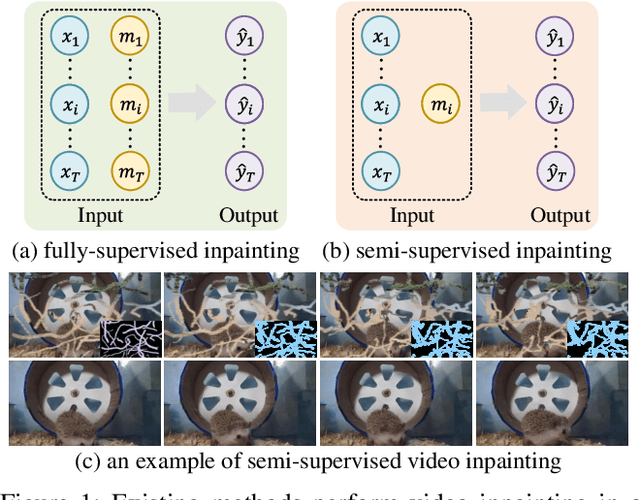
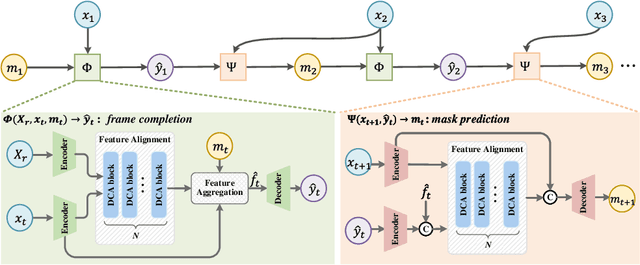
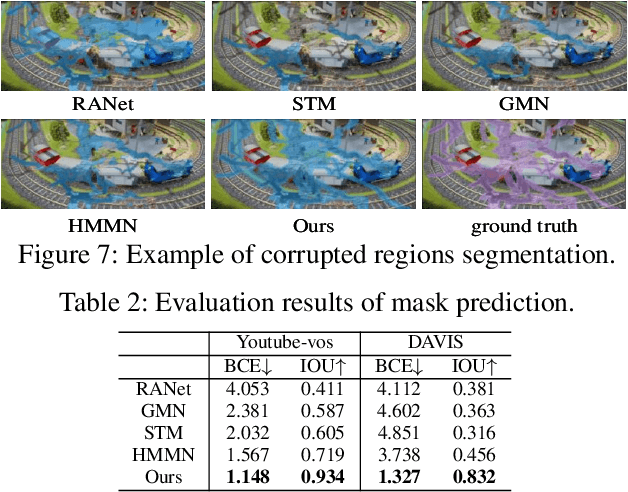
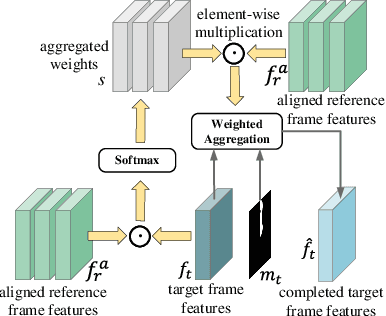
Abstract:Deep learning-based video inpainting has yielded promising results and gained increasing attention from researchers. Generally, these methods usually assume that the corrupted region masks of each frame are known and easily obtained. However, the annotation of these masks are labor-intensive and expensive, which limits the practical application of current methods. Therefore, we expect to relax this assumption by defining a new semi-supervised inpainting setting, making the networks have the ability of completing the corrupted regions of the whole video using the annotated mask of only one frame. Specifically, in this work, we propose an end-to-end trainable framework consisting of completion network and mask prediction network, which are designed to generate corrupted contents of the current frame using the known mask and decide the regions to be filled of the next frame, respectively. Besides, we introduce a cycle consistency loss to regularize the training parameters of these two networks. In this way, the completion network and the mask prediction network can constrain each other, and hence the overall performance of the trained model can be maximized. Furthermore, due to the natural existence of prior knowledge (e.g., corrupted contents and clear borders), current video inpainting datasets are not suitable in the context of semi-supervised video inpainting. Thus, we create a new dataset by simulating the corrupted video of real-world scenarios. Extensive experimental results are reported to demonstrate the superiority of our model in the video inpainting task. Remarkably, although our model is trained in a semi-supervised manner, it can achieve comparable performance as fully-supervised methods.
Description-based Label Attention Classifier for Explainable ICD-9 Classification
Sep 24, 2021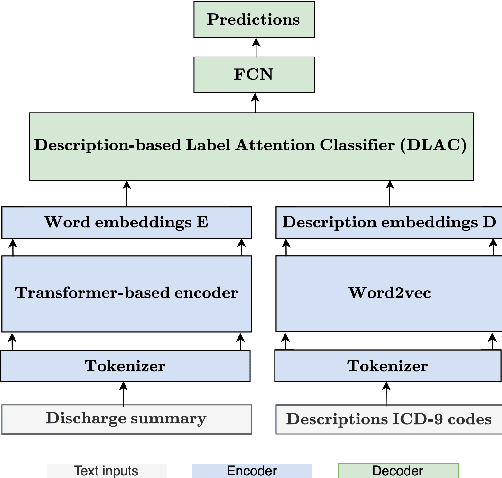
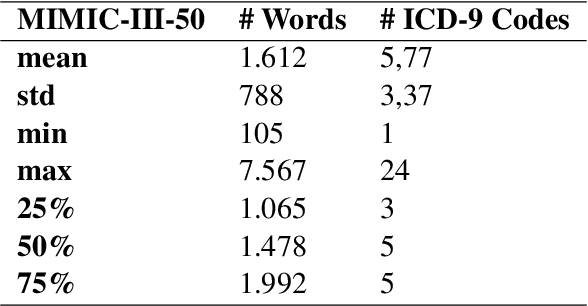
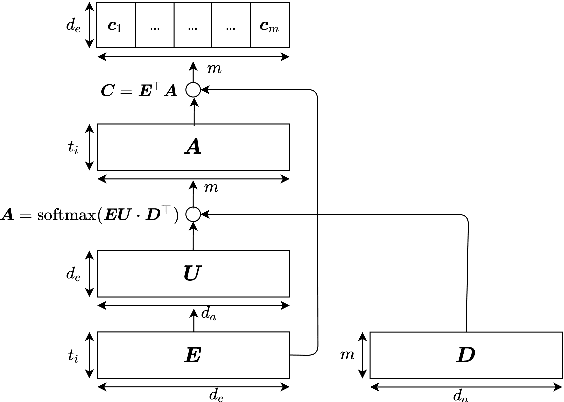
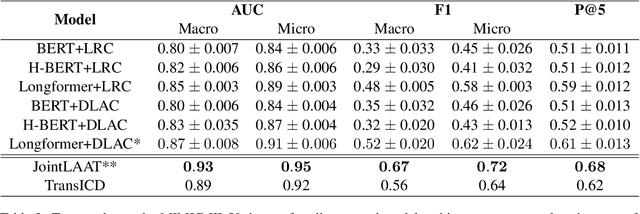
Abstract:ICD-9 coding is a relevant clinical billing task, where unstructured texts with information about a patient's diagnosis and treatments are annotated with multiple ICD-9 codes. Automated ICD-9 coding is an active research field, where CNN- and RNN-based model architectures represent the state-of-the-art approaches. In this work, we propose a description-based label attention classifier to improve the model explainability when dealing with noisy texts like clinical notes. We evaluate our proposed method with different transformer-based encoders on the MIMIC-III-50 dataset. Our method achieves strong results together with augmented explainablilty.
Categorical EHR Imputation with Generative Adversarial Nets
Aug 05, 2021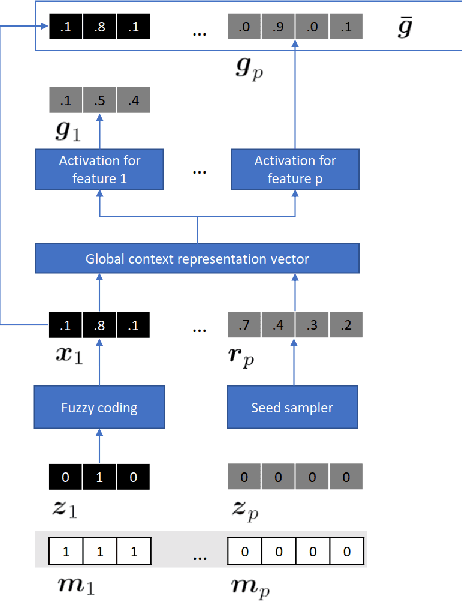
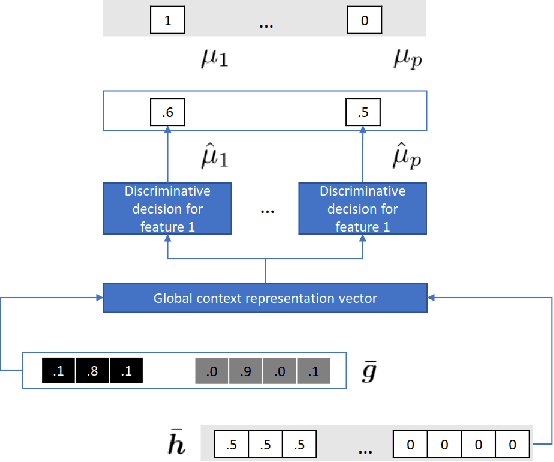
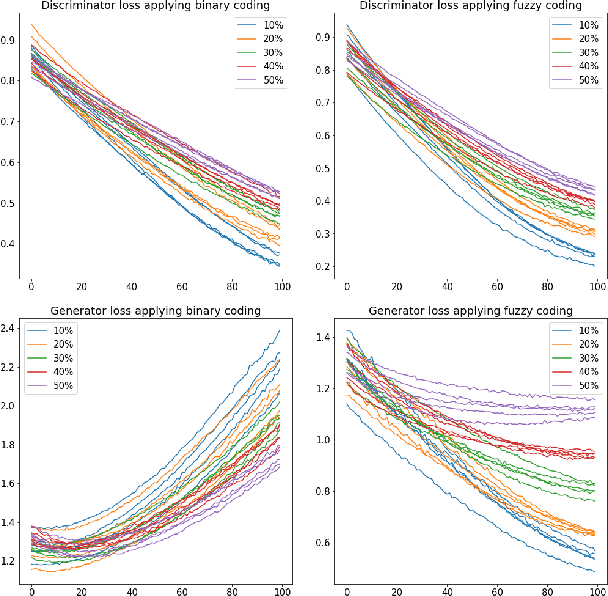
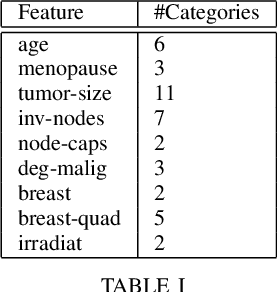
Abstract:Electronic Health Records often suffer from missing data, which poses a major problem in clinical practice and clinical studies. A novel approach for dealing with missing data are Generative Adversarial Nets (GANs), which have been generating huge research interest in image generation and transformation. Recently, researchers have attempted to apply GANs to missing data generation and imputation for EHR data: a major challenge here is the categorical nature of the data. State-of-the-art solutions to the GAN-based generation of categorical data involve either reinforcement learning, or learning a bidirectional mapping between the categorical and the real latent feature space, so that the GANs only need to generate real-valued features. However, these methods are designed to generate complete feature vectors instead of imputing only the subsets of missing features. In this paper we propose a simple and yet effective approach that is based on previous work on GANs for data imputation. We first motivate our solution by discussing the reason why adversarial training often fails in case of categorical features. Then we derive a novel way to re-code the categorical features to stabilize the adversarial training. Based on experiments on two real-world EHR data with multiple settings, we show that our imputation approach largely improves the prediction accuracy, compared to more traditional data imputation approaches.
 Add to Chrome
Add to Chrome Add to Firefox
Add to Firefox Add to Edge
Add to Edge